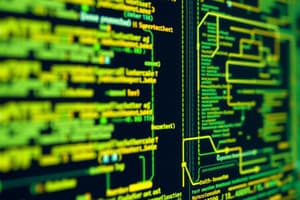Podcast
Questions and Answers
What is the primary role of a database management system (DBMS)?
What is the primary role of a database management system (DBMS)?
- To ensure data redundancy
- To provide network connectivity
- To provide hardware for storing data
- To manage and control the database (correct)
What is the primary purpose of a Database Management System (DBMS)?
What is the primary purpose of a Database Management System (DBMS)?
- To reduce data redundancy and maintain data integrity (correct)
- To enable unauthorized data access
- To create complicated queries for users
- To increase data redundancy
Which of the following best describes a record within a database?
Which of the following best describes a record within a database?
- The highest level of organization within a database
- A collection of related fields (correct)
- The total number of entries in a database
- An individual piece within a table containing only two fields
Which component of a DBMS is responsible for interpreting user queries?
Which component of a DBMS is responsible for interpreting user queries?
How are operational databases typically utilized in an enterprise?
How are operational databases typically utilized in an enterprise?
What does the metadata catalog in a DBMS contain?
What does the metadata catalog in a DBMS contain?
What is the function of data warehouses in enterprises?
What is the function of data warehouses in enterprises?
Which of the following components provides the interface between computers and real-world systems?
Which of the following components provides the interface between computers and real-world systems?
Which of the following is a key function of the optimization engine in a DBMS?
Which of the following is a key function of the optimization engine in a DBMS?
What type of information do fields in a database typically contain?
What type of information do fields in a database typically contain?
What is the role of the log manager within a DBMS?
What is the role of the log manager within a DBMS?
Which statement best describes Database Access Language?
Which statement best describes Database Access Language?
What do procedures in a DBMS encompass?
What do procedures in a DBMS encompass?
Which of the following components is crucial for generating reports in a DBMS?
Which of the following components is crucial for generating reports in a DBMS?
How is a table defined within a database context?
How is a table defined within a database context?
Which of these options is NOT a common component across all DBMS?
Which of these options is NOT a common component across all DBMS?
Study Notes
What is a Database?
- A database is a collection of logically related information that is organized for easy access, management, and updates.
- Databases are typically accessed electronically from a computer system and managed by a database management system (DBMS).
What is Data?
- Data are pieces of information or facts related to a specific object.
- Example: A person's name, age, height, weight, ethnicity, hair color, and birthdate are all data points related to a person.
Key Terms for Understanding Data and Databases
- Field: The most detailed information about events, people, objects, and transactions.
- Record: A collection of related fields.
- Table: A collection of related records with a unique table name.
- Database: A collection of related tables.
Role of Databases in an Enterprise
- Enterprises commonly use both internal and external databases.
- Internal databases: Include operational databases and data warehouses.
- Operational databases: Actively used in business operations like accounting, sales, finance, and HR.
- Data warehouses: Contain data collected from multiple sources, primarily used for business intelligence purposes (not routine business activities).
Components of a Database
- Hardware: Physical devices like computers and hard disks that interface between computers and real-world systems.
- Software: Programs used to manage and control the database, including:
- Database software
- Operating system
- Network software (for data sharing)
- Applications used to access the data
- Data: Raw facts and information that needs to be organized and processed for meaningful interpretation.
- Procedures: Instructions for using a database management system. Examples include:
- Setup and installation instructions
- Login and logout procedures
- Day-to-day operational management
- Data backup procedures
- Report generation instructions
- Database Access Language: A language used to write commands for accessing, updating, and deleting data stored in a database.
What is a Database Management System (DBMS)?
- A collection of programs that enable users to access, manipulate, maintain, report, and relate data within a database.
- DBMS is often used to:
- Reduce data redundancy
- Share data in a controlled way
- Reduce data integrity problems
What is a Database Management System (DBMS)?
- Structured Query Language (SQL) is the standard interface for relational databases, supported by all relational DBMS software.
Components of a DBMS
- Storage engine: The core component that interacts with the file system to store data.
- Query language: Used to interact with the database, from creating databases to inserting/retrieving data.
- Query processor: Interprets user queries and translates them into actionable commands for the database.
- Optimization engine: Provides insights on database and query performance.
- Metadata catalog: Centralized catalog of all database objects.
- Log manager: Records events in the DBMS (logins, activity, backups, etc.).
- Reporting & monitoring tools: Generate reports and monitor database resource consumption and user activity.
Studying That Suits You
Use AI to generate personalized quizzes and flashcards to suit your learning preferences.
Related Documents
Description
This quiz covers fundamental concepts of databases and data, including definitions, key terms, and the role of databases in enterprises. Test your knowledge on fields, records, and how databases are organized for efficient access and management.




